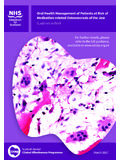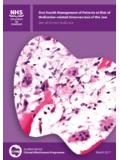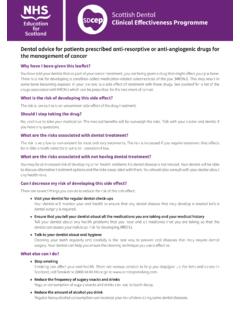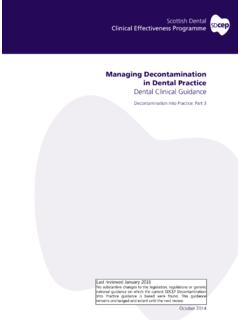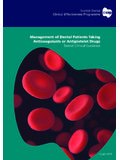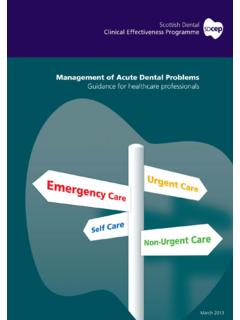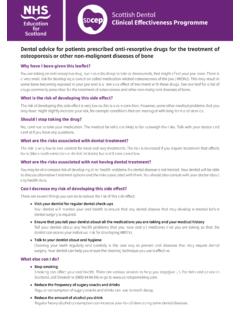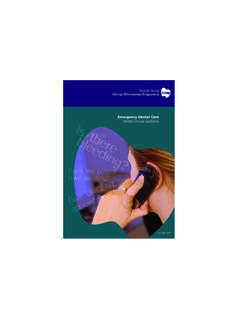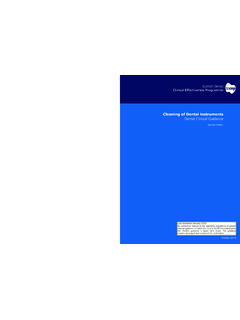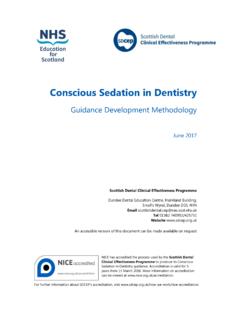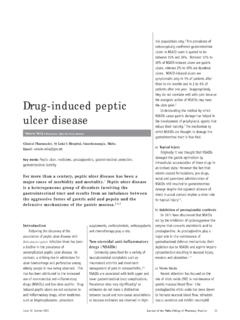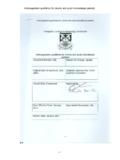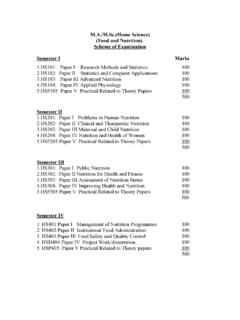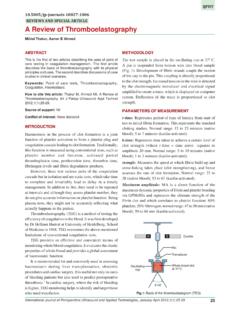Transcription of Management of Dental Patients Taking …
1 Management of Dental Patients Taking Anticoagulants or Antiplatelet DrugsQuick Reference GuideScottish DentalClinical Effectiveness ProgrammeSDcepAugust 2015 For further details please refer to the full guidance, available at Injectable anticoagulant (Section 8)Dalteparin, enoxaparin or tinzaparinOther drug combinationsConsult with general medical practitioner or specialist for more sections indicated in the panels refer to those in the full guidance. Please refer to Table 1 on opposite flap for bleeding risk categories for Dental guidance available at NOACs (Novel Oral Anticoagulants) are also known as DOACs (Direct Oral Anticoagulants) or TSOACs (Target Specific Oral Anticoagulants).Does patient have other relevant medical complications?
2 (Sections & )Which drug type is the patient Taking ?Treat without interrupting medication(Strong recommendation; low quality evidence) Consider limiting initial treatment area and staging extensive or complex procedures; use local haemostatic without interrupting medication(Strong recommendation; low quality evidence)Expect prolonged bleeding; limit initial treatment area and consider staging extensive or complex procedures; actively consider suturing and packingAspirin aloneClopidogrel, dipyridamole, prasugrel or ticagrelor single or dual therapy (in combination with aspirin)Antiplatelet drug(s) (Section 6)Vitamin K antagonist (Section 5)Warfarin, acenocoumarol or phenindioneNovel Oral anticoagulant (NOAC) (Section 7)Dabigatran, apixaban or rivaroxabanGeneral Advice (Section 4)For all Patients Taking anticoagulants or antiplatelet drugs requiring Dental treatment likely to cause bleeding (Table 1):Plan treatment for early in the day and week; treat atraumatically, use appropriate local measures and only discharge the patient once haemostasis has been achieved.
3 If travel time to emergency care is a concern, place particular emphasis on the use of measures to avoid complications; provide patient with written post-treatment advice and emergency contact INR, ideally no more than 24 hours before procedure (up to 72 hours if the patient is stably anticoagulated).If INR is below 4:Treat without interrupting medication(Strong recommendation; low quality evidence) Consider limiting initial treatment area and staging extensive or complex procedures; actively consider suturing and INR is 4 or above, delay treatment or refer if with general medical practitioner or specialist, if early in the day; limit initial treatment area and assess bleeding before continuing; stage extensive or complex procedures; actively consider suturing and bleeding riskdental procedures (Table 1):Advise patient to miss/delay morning dose before treatment* (Conditional recommendation.)
4 Very low quality evidence)Low bleeding riskdental procedures (Table 1):Treat without interrupting medication(Conditional recommendation; very low quality evidence)Advise patient when to restart their medication.*Is medication life-long? (Sections & )Delay Dental treatment where possible or consult with general medical practitioner or Dental treatment likely to cause bleeding? (Table 1)Treat with caution using standard procedures, Taking care to avoid causing a Dental patient Taking an anticoagulant or antiplatelet drug(s)* see back of this guide for further advice on NOAC dosesTable 1 Post-operative bleeding risks for Dental proceduresDental procedures that are unlikely to cause bleedingDental procedures that are likely to cause bleedingLow risk of post-operative bleeding complicationsHigher risk of post-operative bleeding complicationsLocal anaesthesia by infiltration, intraligamentary or mental nerve block Local anaesthesia by inferior Dental block or other regional nerve blocks Basic periodontal examination (BPE)
5 Supragingival removal of plaque, calculus and stain Direct or indirect restorations with supragingival margins Endodontics - orthograde Impressions and other prosthetics procedures Fitting and adjustment of orthodontic appliancesSimple extractions (1-3 teeth, with restricted wound size)Incision and drainage of intra-oral swellings Detailed six point full periodontal examinationRoot surface instrumentation (RSI) and subgingival scalingDirect or indirect restorations with subgingival marginsComplex extractions, adjacent extractions that will cause a large wound or more than 3 extractions at onceFlap raising procedures: Elective surgical extractions Periodontal surgery Preprosthetic surgery Periradicular surgery Crown lengthening Dental implant surgeryGingival recontouringBiopsies There is no evidence to suggest that an inferior Dental block performed on an anticoagulated patient poses a significant risk of bleeding.
6 Table 1 categorises Dental procedures according to the risk of post-operative bleeding complications. This table should be used as part of the assessment of bleeding risk for the patient, to inform patient Management and treatment planning guided by the Dental Clinical Effectiveness ProgrammeDundee Dental Education Centre, Frankland Building, Small s Wynd, Dundee DD1 4 HNEmail l 01382 425751 / 425771 Website dose schedules for Dental procedures with a higher risk of bleeding complicationsThis Quick Reference Guide aims to provide Dental professionals with a convenient aid to decision making for the Management of Patients Taking anticoagulants or antiplatelet drugs. The information provided within this guide is extracted from the Scottish Dental Clinical Effectiveness Programme (SDCEP) Management of Dental Patients Taking Anticoagulants or Antiplatelet Drugs guidance and is not comprehensive.
7 The user should refer to the guidance for a full explanation of the recommendations, the basis for them, and for other points that should be considered when managing these Patients . The full guidance is available at drug scheduleMorning dose(pre-treatment)Post-treatment doseapixabanor dabigatranTwice a dayMiss morning doseUsual time in evening rivaroxabanOnce a day; morningDelay morning dose4 hours after haemostasis has been achievedOnce a day; eveningNot applicableUsual time in evening As long as no earlier than 4 hours after haemostasis has been patient should continue with their usual drug schedule | Designed and typeset by the NES Design Service.
